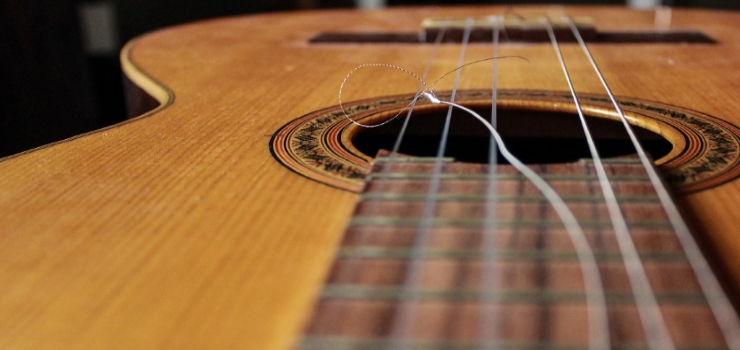To change the strings on your ukulele, follow these steps:
Learning how to string a ukulele is a fundamental part of being a ukulele player. Because of how frequently strings need to be changed, it is better to learn how to replace ukulele strings on your own (to save on costs). The first question in the minds of the beginners is how do you know that it’s time to change the strings? So, before we dive into the step by step guide for changing the strings, let us first discuss when to change them.
Contents
There are several cues that tell you when it’s time to restring your ukulele. Starting from the most obvious ones, when a string breaks on your ukulele you would have to change them. The thing to note is you never have to change just one of four strings. Always change all of the strings, as you don’t want the new strings to get jumbled up with the old ones.

If your ukulele starts to sound dull then it’s probably time to change the strings. New strings will give you a more energetic and brighter sound. If any kind of rust or oil appears on the fretboard or the strings, this is another cue. Typically, the strings should be changed in 3-6 months, or if you use your ukulele frequently or professionally, change the strings every 1-3 months.
Changing the strings of your ukulele includes 5 steps.
Go through the guide below to learn how to restring a ukulele:
This is by far the easiest step, unless your ukulele is pretty old and the strings are solidified to the pegs. If such a situation is faced, it is easier to use a clipper and clip off the strings. Be careful to not harm the wood of your ukulele while doing so. Otherwise, detach the strings by unwinding from the pegs to loosen up the strings and unfasten it. Open up the knot and detach the string from the bridge. Repeat for all the four strings and remove them.
Once you have removed all the strings you are at a challenge. If you get done with this step, the rest of the procedure of changing the strings wouldn’t be a problem at all. There are many different types of bridges of a ukulele. Here we will discuss the procedure of the two most common ones, a slotted bridge, and a tie-bar bridge.
The slotted bridge is really easy to work with and changing strings would never be a problem if you have a ukulele that has a slotted bridge. All you have to do is to tie a knot at one end of the string and insert it in the slot of the bridge. A simple knot would work but it is better to do a double knot or a figure 8 knot to make your strings more secure. Attach all 4 strings in the slots the same way.
If you are using a ukulele with a tie-bar bridge, which is the most common one, prepare for a bit of a work. This type of bridge has holes in it, and you have to tie a different kind of knot to keep the string in place. Start by passing the string through the hole from the base side of the ukulele and comes out from the upper side of the bridge.
Get hold of a good few inches to tighten the knot start by moving the end of the string that is coming out of the bridge around the part of the string that is going downwards and into the bridge from below. Move the string a couple of times in the knot you are making, and stretch the lengthy side of string to make the knot tighter so it stays in place.
You can also avoid all of this by simply buying a bridge bead, which is available in any music store. Simply tie a knot at one side of the string as we did for the slotted bridge. Pass the string through the bead and then through the bridge. In this way, you will have a bead at the bottom of the bridge. This can save you from all the hassle of the knot and would make the changing of the strings easier.
Once your strings are attached to the bridge, you can simply wind the other end of the strings around the tuning pegs. Start by holding the edge of the string and winding it around the peg. Make sure to keep one finger on the knot at the bridge while doing this step to make sure that the knot doesn’t loosen. Starting from the edge keep winding up the string until it holds itself in place. Repeat with all the four strings.
Tighten up the string while keeping an eye on the ridge knot and the tuning peg. There are some winding tools that make the work easier. Do not over tighten the strings to the point that they snap.

After you are done with attaching the strings, it’s time to tune up the ukulele. Lay the ukulele flat and start by pulling a string one by one from the middle to remove the tension. Some strings take some time to stretch, and in this way you can speed up the process. Be careful not to break the string while stretching. Tighten the strings and to the tune and repeat for all the four strings.
Every beginner finds changing the strings a bit challenging at first, but the process gets easier with time. After a few times, stringing your ukulele will become natural and not difficult. Learning how to change ukulele strings is an important and valuable skill that will last you a lifetime.
Copyright © 2024 MSpot. All rights reserved. Privacy Policy & Cookie Disclaimer.
mspot.com is a participant in the Amazon Services LLC Associates Program, an affiliate advertising program designed to provide a means for sites to earn advertising fees by advertising and linking to Amazon.com. As an Amazon Associate, we earn from qualifying purchases.